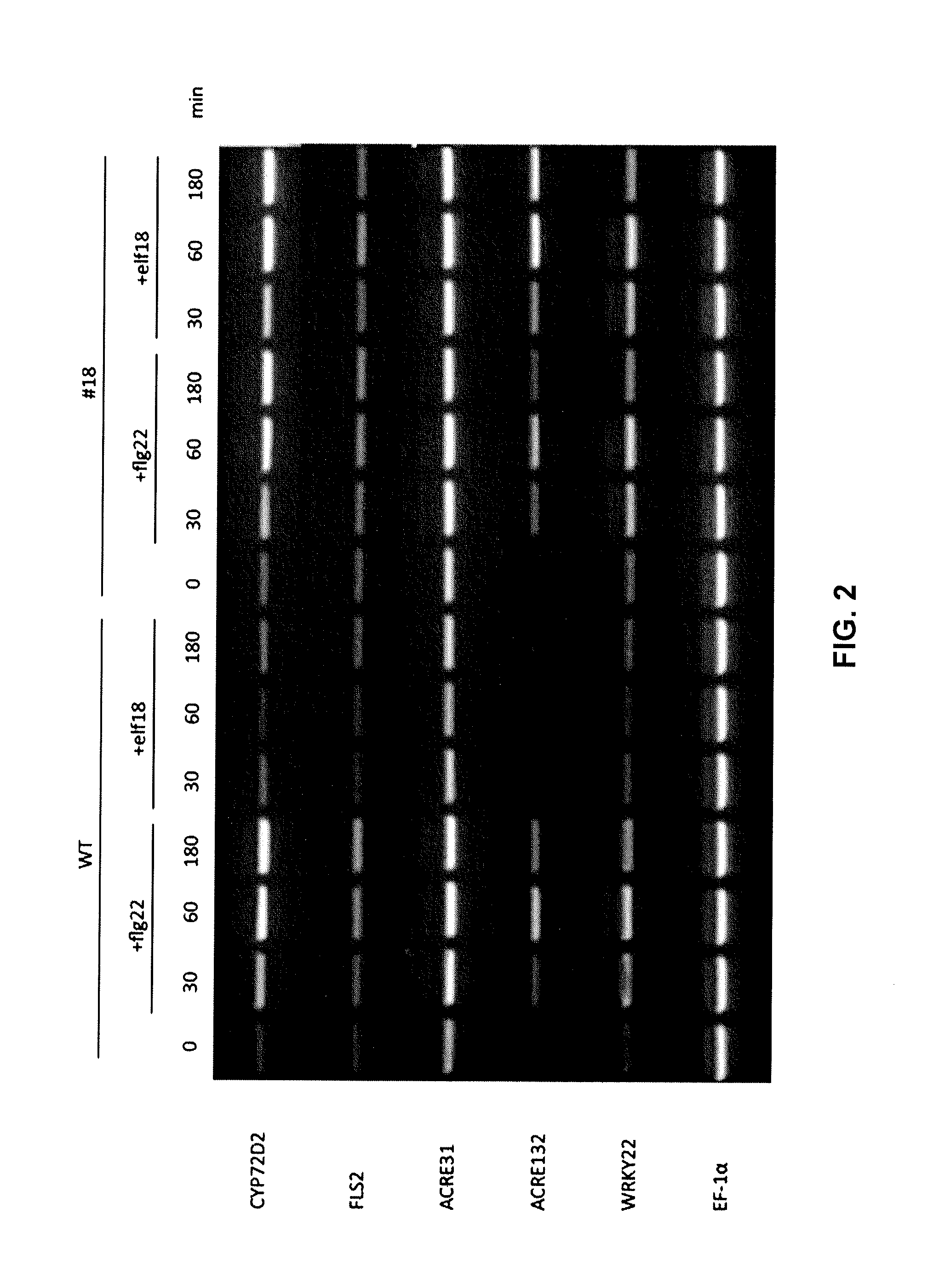Methods of enhancing the resistance of plants to bacterial pathogens
a technology of bacterial pathogens and resistance of plants, applied in the field of enhancing the resistance of plants to bacterial pathogens, can solve the problems of major social and economic problems of plant diseases, and achieve the effect of enhancing the resistance of plants and at least enhancing the resistance of bacterial pathogens
- Summary
- Abstract
- Description
- Claims
- Application Information
AI Technical Summary
Benefits of technology
Problems solved by technology
Method used
Image
Examples
example 1
Characterization of Transgenic Nicotiana benthamiana (Nb) Stably Expressing AtEFR
[0104]Although plant defense responses are not altogether understood at a molecular level, they can be used to assay for the ability of a plant to anticipate a microbial attack. In this project, four well-known PTI responses were used to assay for the ability of heterologously expressed AtEFR to confer responsiveness to the EF-Tu epitope elf18. The well-characterized flg22 epitope of flagellin is used as a positive control and water or assay mix is used as a negative control. The use of the epitopes elf18 and flg22 instead of the whole elicitor or pathogen ensures each treatment is one specific elicitor, not several acting together.
Materials and Methods
[0105]All experiments used homozygous T4 Nb lines (subsequently referred to as EFR) expressing AtEFRp::EFR as well as wild-type Nb as a negative control. In most cases, treatments used 100 nM elf18 or flg22 diluted in water, MS-10, or the relevant assay m...
example 2
Characterization of Transgenic Tomato Stably Expressing AtEFR
Characterization of Tomato and Potato Primary Transformants
[0131]In parallel to characterizing transgenic Nb, other members of the Solanaceae family, Solanum lycopersicum (tomato, var. Moneymaker) and Solanum tuberosum (potato, var. Desiree), were also used for a preliminary investigation. Fifteen primary transformants expressing AtEFRp::EFR and 21 expressing 35S::AtEFR for tomato, and 7 primary transformants expressing AtEFRp::EFR and 11 expressing 35S::AtEFR for potato were tested to identify lines that gained EF-Tu responsiveness for further physiological and molecular characterization.
Oxidative Burst: Luminol-Based Assay
[0132]To measure the production of reactive oxygen species (ROS) in leaf tissue, size #1 leaf discs (Nb; n=12, tomato and potato; n=8) were floated overnight in water. Each disc was then transferred to a well containing an assay mix of luminol (200 μM) and peroxidase (20 μg / ml) in 100 μl water. Each wel...
example 3
Transformation of Banana with AtEFR
[0136]Embryogenic suspension cultures of banana are prepared as described (Côte et al. (1996) Physiol. Plant. 97:285-290). Embryogenic suspension cells are co-cultivated with Agrobacterium cells containing a T-DNA vector containing a chimeric AtEFR gene under the control of the maize polyubiquitin-1 promoter Becker et al. (2000) Plant Cell Rep. 19:229-234), and a selectable marker gene consisting of the NPTII coding sequence under the control of the 35S promoter. Transformed calli are selected on medium containing kanamycin. Transformed calli (i.e., kanamycin-resistant calli) are then regenerated into transformed banana plants using standard methods. See, U.S. Pat. No. 5,792,935 U.S. Pat. No. 6,133,035; May et al. (1995) Biotechnology 13:486-492; Dhed'a, et al. (1991) Fruits 46:125-135); Sagi, et al. (1995) Biotechnology 13:481-485; Marroquin et al. (1993) In Vivo Cell. Div. Biol. 29P:43-46; Ma (1991) “Somatic Embryogenesis and Plant Regeneration f...
PUM
| Property | Measurement | Unit |
|---|---|---|
| temperature | aaaaa | aaaaa |
| temperature | aaaaa | aaaaa |
| pH | aaaaa | aaaaa |
Abstract
Description
Claims
Application Information
 Login to View More
Login to View More - R&D
- Intellectual Property
- Life Sciences
- Materials
- Tech Scout
- Unparalleled Data Quality
- Higher Quality Content
- 60% Fewer Hallucinations
Browse by: Latest US Patents, China's latest patents, Technical Efficacy Thesaurus, Application Domain, Technology Topic, Popular Technical Reports.
© 2025 PatSnap. All rights reserved.Legal|Privacy policy|Modern Slavery Act Transparency Statement|Sitemap|About US| Contact US: help@patsnap.com



